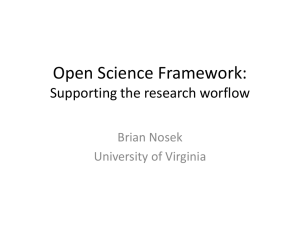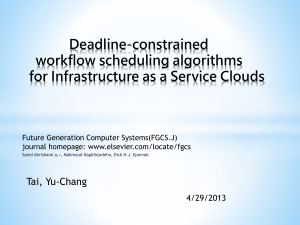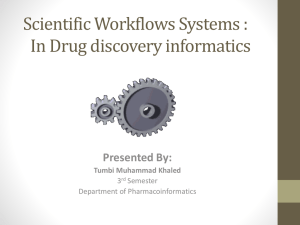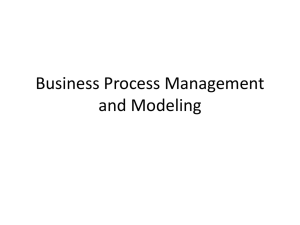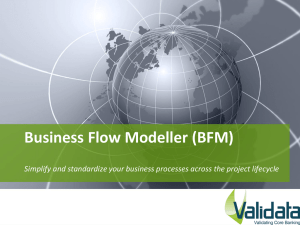Slide - PDCC - Nanyang Technological University
advertisement
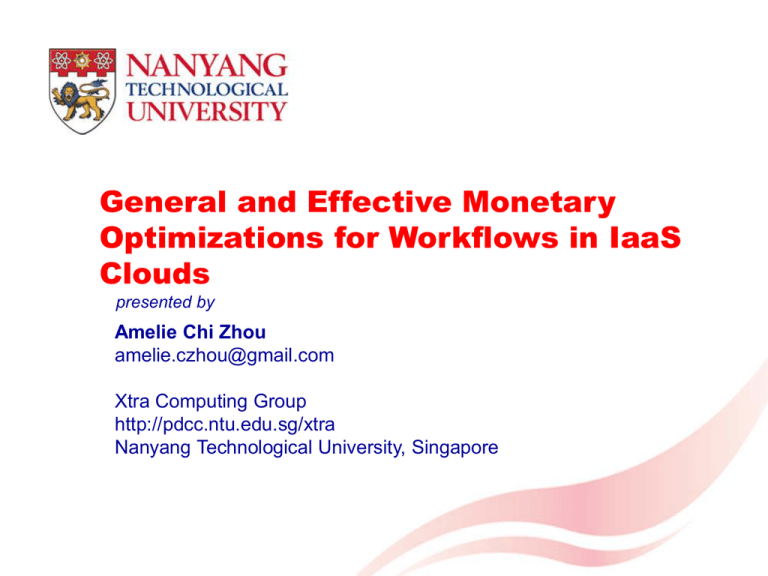
General and Effective Monetary Optimizations for Workflows in IaaS Clouds presented by Amelie Chi Zhou amelie.czhou@gmail.com Xtra Computing Group http://pdcc.ntu.edu.sg/xtra Nanyang Technological University, Singapore 1 Workflows for Scientific Applications • Workflows are structured – Tasks have very different I/O and computational behavior. • Real-world workflows – Montage, Ligo, Epigenomics, water-simulation Montage Ligo Epigenomics • Workflow ensembles [Malawski et al., SC’12] – Composition of workflows with similar structures and different parameters and priorities 2 Running Workflows on IaaS Clouds • Define IaaS clouds – Provide fundamental computing resources for users to provision – Examples: Amazon EC2, Rackspace, OpenStack, Google Compute Engine … • Example projects – Montage, Broadband, Epigenomics on Amazon EC2 [Juve et al., eScience’09] – Astronomy applications on Nimbus, Eucalyptus, and EC2 [Vöckler et al., ScienceCloud’11] – … 3 Workflows in IaaS Clouds • Features of IaaS clouds – Pay as you go (e.g., hourly pricing scheme) – Rich and evolving cloud offerings • Research problems – Monetary cost optimizations – Performance optimizations – Elasticity – Fault tolerance – … Are the current solutions ideal/sufficient? 4 Monetary Cost Opportunities • Instance types – Amazon EC2 provides 29 types of instances • Instance reuse – Hourly charging scheme • Pricing schemes – On-demand, spot and reserved pricing V.S. • Tasks can have very different I/O and computational behavior. • Workflows have different deadline and monetary constraints. • Users may have various workflow application scenarios. 5 Current Solutions are Far From Ideal • Problems of current approaches – Auto-scaling [Mao et al., SC’11] resource management • More effective optimizations 29% less cost – Assume static cloud performance and pricing • Cloud dynamics + spot instances 73% less cost – Heuristic-based cost and performance optimizations are specific. • They are likely to be suboptimal in evolving and diversified workflow applications. 29% 73% 6 Our Research Efforts • Effectiveness – Dyna: Minimize the monetary cost of workflows, addressing both the price and performance dynamics in clouds • Generality – ToF: Define transformation operations to model common cost and performance optimizations – Deco: Design a declarative language called WLog to specify various workflow optimization problems The focus of this presentation. 7 Overall Design • We design general workflow optimization frameworks to fully explore the optimization opportunities that lie in workflows Problem specification layer Wlog programs Deco Optimization layer Transformationbased Optimizer ToF Execution layer 8 Outline • Related Work • Generalized Optimization Frameworks – General transformations for cost and performance optimizations – A declarative language for workflow optimization problems • Conclusions 9 Related Work • Performance and monetary cost optimization heuristics – Auto-scaling [Mao et al., SC’11] • Fixed sequence of workflow optimizations – Workflow scheduling with performance and cost constraints [Kllapi et al., SIGMOD’11] • Consider only one on-demand instance type The heuristics are specifically designed for specific optimization problems and the optimization opportunities are not fully explored. 10 Related Work (cont’d) • Generalized optimization frameworks: overhead is a problem – Generalized bin-ball abstraction for resource allocation [Rai et al., SoCC’12] • GPU acceleration • Not always convenient to model a problem with the bin-ball model – Declarative language to model a wide range of COPs [Liu et al., VLDB’12] • Distributed systems • Ignorant to the special features and optimization opportunities in workflows There is no general optimization framework for workflows. 11 Outline • Related Work • Generalized Optimization Frameworks – General transformations for cost and performance optimizations – A declarative language for workflow optimization problems • Conclusions 12 ToF: A Transformation-based Optimization Framework • Outline – Main contributions of this work – System overview – Design details – Evaluation results 13 Main Contributions • This study has two major contributions – We define a series of common transformations for the performance and cost optimizations of workflows. – We design a light-weight optimizer to guide the transformation process. 14 Workflow Transformation • Definitions – Instance assignment graph • Each node represents instance configuration for a task. • Same structure as the workflow DAG – Transformation operation • Structural change in the instance assignment graph 0 0 0 Transformations 1,2 1 2 3 3 0 2 2,3 1 0 1,3 1,2,3 15 System Overview • Design ideas – Two types of transformations • Main schemes: reduce cost • Auxiliary schemes: help main schemes to reduce cost – Use cost model to guide the transformation optimization – Periodical batch optimization • Maximize instance sharing and reuse • Reduce optimizer overhead Main Schemes Cost model Auxiliary Schemes No Termin ation? Yes Output Optimization process in one plan period 16 Design Details • Transformation operations – Main schemes: Merge, Demote – Auxiliary schemes: Move, Promote, Split, Coscheduling – Transformations can combine with each other 17 Using Transformations • Example of using Move and Merge operations Only transform shape Reduces cost Charging hours: 𝟏 + 𝟏 + 𝟏 = 𝟑 (𝟑𝟎 + 𝟒𝟎 + 𝟒𝟎)/𝟔𝟎 = 𝟐 18 Experimental Setup • Workload – Montage, Ligo and Mixed – Workflow submission rate follows Poisson distribution • Comparisons – – – – ToF Baseline: only implement the initial instance configuration Auto-scaling [Mao et al., SC’11] Greedy: randomly select the transformation during optimization • All results are normalized to Baseline 19 Evaluation Results on Cost Optimizations 29% 17% 21% 16% 28% 15% Optimization results under the pricing scheme of Amazon EC2. ToF obtains the lowest monetary cost on all workflows. • Over Auto-scaling by 29% • Over Baseline by 27% • Over Greedy by 17% 20 Evaluation Results on Performance Optimizations 21% 18% 21% 8% 16% 12% Performance optimization results. ToF obtains the lowest average execution time on all workflows. • Over Auto-scaling by 21% • Over Baseline by 21% • Over Greedy by 18% 21 Outline • Related Work • Generalized Optimization Frameworks – General transformations for cost and performance optimizations – A declarative language for workflow optimization problems • Conclusions 22 Deco: A Declarative Optimization Framework • Outline – Main contributions of this work – System overview – A declarative language for workflows – GPU-accelerated search engine – Evaluation results 23 Main Contributions • This work has three main contributions – A declarative language for resource provisioning of scientific workflows in IaaS clouds – A generalized optimization framework to serve a wide range of optimization problems – Fast GPU-based implementation for low optimization overhead 24 Motivating Ideas • Why declarative language? – Declarative languages like HTML, SQL, Prolog – Concise and clear – Focus on what to do rather than how to do it • Why GPU acceleration? – Generic search has large runtime overhead – Monte Carlo method is used for probabilistic approximation [Raedt et al. 2007] which is suitable for GPU acceleration 25 System Overview • Overview of the Deco system – WLog, a declarative language for workflows – GPU-Accelerated search engine 26 WLog – A Declarative Language for Workflows • WLog is designed based on Prolog • A WLog program describing a workflow scheduling problem goal minimize Ct in totalcost(Ct). deadline(P, D) A probabilistic deadline cons deadline(95%, 10h). requirement that D is at the P-th percentile of var configs(Tid, Vid) forall task(Tid) and Vm(Vid). workflow execution time. r1 r2 r3 r4 r5 r6 r7 problem specific keywords: import(amazonec2).• goal Optimization goal defined by the user. import(montage). • cons Problem constraint defined by the user. path(X,Y,Y,C) :- edge(X,Y), exetime(X,Vid,T), C is T. • var Problem variable to be optimized. path(X,Y,Z,C) :- edge(X,Z), Zn==Y, path(Z,Y,Z2,C1), exetime(X,Vid,T), import(cloud) Import the cloud-related facts from C is T+C1. the cloud metadata. maxtime(Path,T) :- setof([Z,C],path(root,tail,Z,C),Set), max(Set,[Path,T]).import(daxfile) Import the workflow-related facts generated from a DAX file. cost(Tid,Vid,C) :- price(Vid,Up), exetime(Tid,Vid,T), C is ceil(T/60.0)*Up. totalcost(Ct) :- findall(C,cost(Tid,Vid,C),Bag), sum(Bag,Ct). 27 GPU Accelerations • Explore vs. exploit – By exploit, partial results are prioritized. – Exploration traverses the search tree level by level which offers GPU a opportunity to parallel the searching process. • Memory optimizations – Minimize the usage of global memory – Reduce accesses to shared memory 28 Evaluation Settings • Three use cases – Workflow scheduling problem – Workflow ensemble [Malawski et al., SC’12] • Goal: execute more workflows with high priorities within given budget and deadline – Follow-the-cost: multiple workflows, multiple datacenters • Comparison for workflow ensemble problem – Algorithms: Deco vs. SPSS [Malawski et al., SC’12] – Ensemble types: constant, Uniform(Un)sorted, Pareto(Un)sorted – Generate 5 budgets between [MinBudget, MaxBudget] • All results are normalized to that of SPSS 29 Evaluation Results • Under all ensemble types and budget constraints – Deco obtains better score metric value than SPSS Obtained score results of SPSS and Deco with different ensemble types under budget 1 to 5 and fixed deadline. Workflow type is Ligo. 30 Evaluation Results (cont’d) • Programmability of WLog in Deco (lines of codes) – Users (re-)implement the workflow application in C++. – With Deco, users implement in WLog. Use Case C++ Implementation WLog Workflow Scheduling 1950 10 Workflow Ensemble 1960 13 Follow-the-Cost 2230 15 Deco allows much lower coding complexity than manual implementation. 31 Performance Speedup of GPUs • Performance speedup of GPU implementation over CPU implementation on a single core for the three applications GPU Accelerations 500 437x 400 300 200 93x 100 31x 0 Montage Epigenomics Ligo 32 Outline • Related Work • Generalized Optimization Frameworks – General transformations for cost and performance optimizations – A declarative language for workflow optimization problems • Conclusions 33 Conclusions • IaaS clouds have become an attractive platform for hosting workflows. • Despite recent efforts in monetary cost optimizations of workflows in the cloud, there is still a large room for further improvements. • Due to the complex cloud offerings and problem specifications, we develop general optimization frameworks. – ToF achieves up to 29% improvement over the state-ofthe-art algorithm. – Deco achieves up to 77% improvement over the state-ofthe-art algorithm. 34 Future Work • Energy-efficient Cloud – Reduce the investment cost of cloud provider to potentially reduce instance price with energy-efficient hardware/software • Optimization opportunities in Multi-Cloud – Utilize different cloud offerings, e.g., instance types, to further reduce cost 35 References • • • • • • • • • • • Maciej Malawski, Gideon Juve, Ewa Deelman, and Jarek Nabrzyski. 2012. Cost- and deadlineconstrained provisioning for scientific workflow ensembles in IaaS clouds. SC '12. 11 pages. Juve, G.; Deelman, E.; Vahi, K.; Mehta, G.; Berriman, B.; Berman, B.P.; Maechling, P., "Scientific workflow applications on Amazon EC2," E-Science Workshops, pp.59,66, 9-11 Dec. 2009. Jens-Sönke Vöckler, Gideon Juve, Ewa Deelman, Mats Rynge, and Bruce Berriman. 2011. Experiences using cloud computing for a scientific workflow application. ScienceCloud '11. P15-P24. 2011. Ming Mao, Marty Humphrey: Auto-scaling to minimize cost and meet application deadlines in cloud workflows. SC 2011: 49. Herald Kllapi, Eva Sitaridi, Manolis M. Tsangaris, and Yannis Ioannidis. 2011. Schedule optimization for data processing flows on the cloud. SIGMOD '11. 289-300. Anshul Rai, Ranjita Bhagwan, and Saikat Guha. 2012. Generalized resource allocation for the cloud. SoCC '12. Article 15 , 12 pages. Changbin Liu, Lu Ren, Boon Thau Loo, Yun Mao, and Prithwish Basu. 2012. Cologne: a declarative distributed constraint optimization platform. Proc. VLDB Endow. 5, 8 752-763. L. De Raedt, A. Kimmig, and H. Toivonen, ProbLog: A probabilistic Prolog and its application in link discovery, IJCAI 2007, pages 2462-2467, 2007. Amelie Chi Zhou, Bingsheng He, Transformation-based Monetary Cost Optimizations for Workflows in the Cloud, accepted by TCC, Dec 2013. Amelie Chi Zhou, Bingsheng He, A declarative optimization framework for workflows in IaaS clouds, submitted to SC 2014. Amelie Chi Zhou, Bingsheng He, Cheng Liu, Monetary Cost Optimizations for Hosting Workflow-as-aService in IaaS Clouds, submitted to ToC, 2014. 36 Thank you! Amelie Chi Zhou amelie.czhou@gmail.com Advisor: Bingsheng He bshe@ntu.edu.sg Xtra Computing Group http://pdcc.ntu.edu.sg/xtra Nanyang Technological University, Singapore 37

